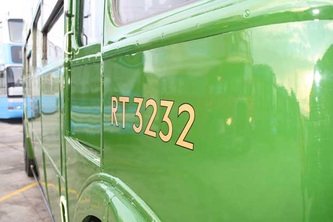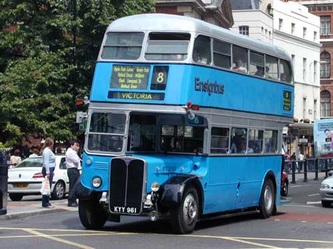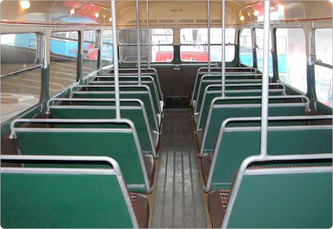Recent Photos
Older Photos
|
RT3232
Seating Capacity:
56 (30 upstairs and 26 downstairs) Special features: Ideal for film work and weddings Description:
The Classic RT design originally entered service in 1939 and 150 of them served in London during World War II. Production resumed at the end of hostilities and eventually 7,000 of the buses supplied almost the entire London bus network. They formed one of the greatest standardised fleets ever assembled in the world. Withdrawn from London service by 1979 they remain a timeless and nostalgic link to a different way of life. This bus started life as one of the wonderful Green Line coaches operating express services into Aldgate, later painted red, this bus went on to survive almost to the end of RT operation in 1979. It was our very first vintage fleet vehicle purchased directly from London Transport, and has been with Ensignbus now longer than it was with London Transport. Vehicle History
RT Class History:
The RT is surely one of the best know types of London bus with a look that is timeless as well as being a design classic. RT’s have featured in films, such as ‘Summer Holiday’ or James Bonds ‘Live and Let Die’ all adding to the familiarity of the type. The first RT took to the road in service weeks before the start of World War II and hence became the only true Pre War RT, however with the other 149 of this batch entering service throughout the next two years before hostilities ceased, these first 150 are universally all known as the Pre War batch.Following the end of the war it had been decided that the RT would form the majority of London double deck fleet and some modifications were made to the post war design to improve on what had been learnt from the operation of the pre war batch, thus started one of the great fleet replacements of war weary types as quickly as possible. By 1948 RT’s were entering service in a steady stream, there were however numerous delays and shortages caused by the lack of parts and skilled workers so soon after the end of hostilities. Body production was quicker than chassis leading to some new RT bodies being mounted onto STL chassis, thus making the short lived SRT class, (of which our very own RT4421 is one, formerly SRT 119). To also help production non standard body builders were used in addition to Park Royal and Weymann, Saunders and Cravens also built a few hundred examples see our RT1431 and RT1499 for Cravens examples.By 1955 bus use had dramatically declined and LT had more buses than it was ever going to need, so the first non standard types, the Cravens, were withdrawn and sold on. Further withdrawals continued as the new Routemasters started to appear in the late 1950’s.However the RT was a survivor and following its hey day, where nearly 7,000 were in service, they took a very long time to replace. The last one (RT624 also now in our fleet) ran on the East London route 62 in April 1979 bringing to an end 40 years of continuous operation of this type, a record many thought would never be beaten. However, its successor the RM did manage to achieve this extraordinary feat lasting in service until 2005.It’s true to say that when people are asked to draw or describe a London bus it is generally one of these two types people will think off, such is the iconic regard they achieved however with the RT having been built in such austere times and having operated through such harsh conditions its longevity is a real credit to its type. For more on this class why not visit Ian's Bus Stop RT3232 RT3232 has only ever had two owners, London Transport and Ensignbus, making its history somewhat easier to track than many RTs. The vehicle was new to LT in May 1950 as one of the famous Romford Green Line vehicles that wore a dark livery and had embossed Green Line badges on the side rather than the later transfers. It operated on the commuter routes from areas such as Brentwood on the routes 721, 722 and 726. These vehicles were the first RTs to have heaters and were the forerunners of the more luxuriously appointed RMC/RCL class taht would follow in the 1960’s. It continued to operate from Romford until June 1965 when it transferred across to first Amersham, then High Wycombe, Tring, and Garston. It was whilst out in the country area that ownership had passed from London Transport to the newly created London Country in January 1970. 3232 was one of the buses selected by LC to be sold back to LT which duly happened in 1972 when 3232 returned to the red livery of the Central Area. She would then become a bit of a journeyman transferring from one garage to another as more and more routes lost their RT’s spending time at Bow, Bromley, Camberwell, Brixton, Poplar, Shepherds Bush and Harrow Weald, before being downgraded to a driver trainer and operating at Hornchurch and Wood Green before finally being withdrawn in November 1979, some seven months after the last RT’s had been withdrawn from service and having given nearly 30 years service.A week after withdrawal it was with Ensignbus where it was restored back to it original Green Line livery, before going into fleet colours of blue and silver and making guest appearances back in London service. A period in red and silver followed when it helped out on London sightseeing duties with Ensign owned London Pride. By 1998 it was in need of a refurbishment and was completely stripped down, in 2010 the interior was again tackled to bring the condition up to a higher standard. Currently wearing the blue and silver Ensignbus livery the vehicle is maintained to passenger carrying standard and works as part of the heritage fleet. Technical Specifications: Date of first registration: August 1950 Chassis: AEC Regent III Chassis number: 9614081 Engine: AEC 9.6 Fuel: Diesel Body Code: 6930 Body: Weymann Lengh: 26’ Seating: 56 seats, 26 downstairs & 30 upstairs |





















